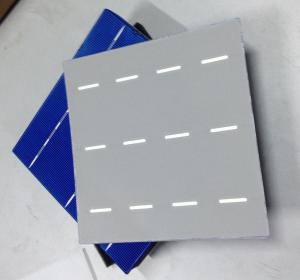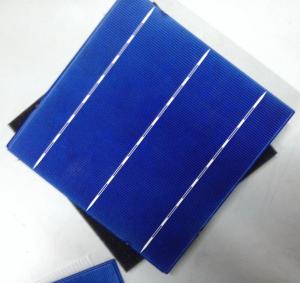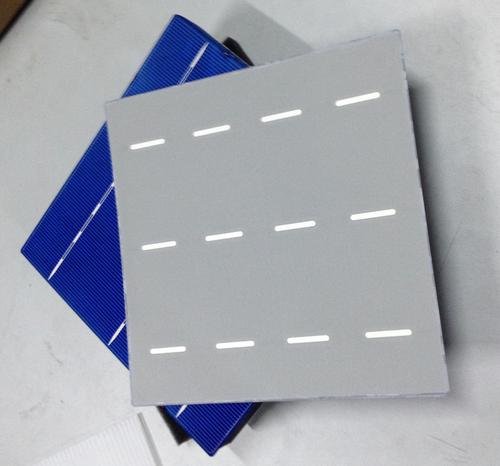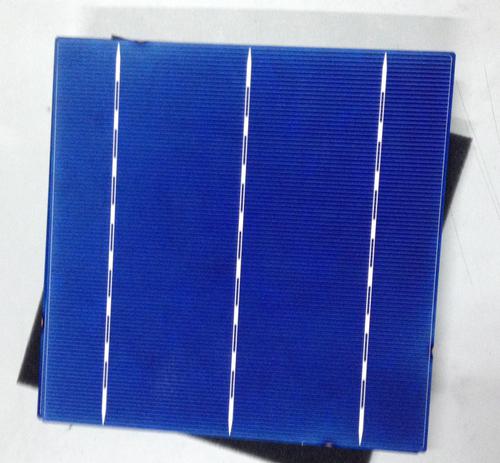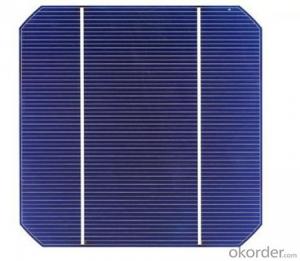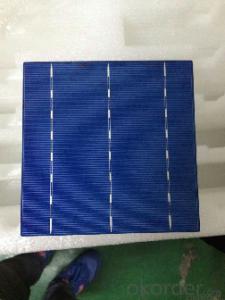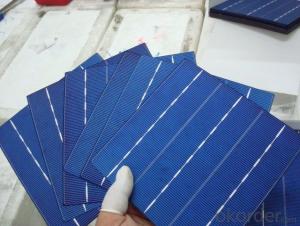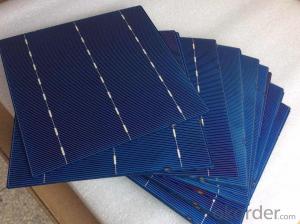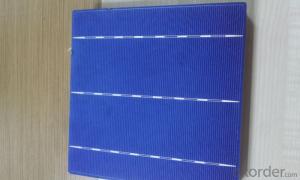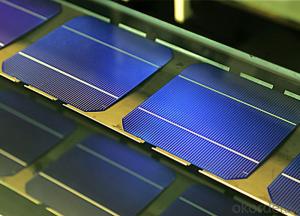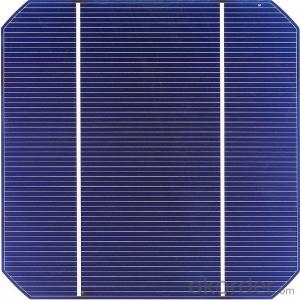Best Solar Cells - Polycrystalline Solar Cells Tire 1 Manufacturer -17.4%
- Loading Port:
- Shanghai
- Payment Terms:
- TT OR LC
- Min Order Qty:
- 10000 pc
- Supply Capability:
- 50000000 pc/month
OKorder Service Pledge
OKorder Financial Service
You Might Also Like
Specifications of Poly Solar Cells
Format 156 mm × 156 mm ± 0.5 mm
Thickness- 210μm ± 40 μm
Front (-) 1.5mm bus bars (silver),blue anti-reflection coating (silicon nitride)
Back (+) 2.5mm wide soldering pads (silver) back surface field (aluminium)
Temperature Coefficient of Poly Cells
Voc.Temp .coef.%/K -0.351%/K
Isc.Temp .coef.%/K +0.035%/K
Pm.Temp. coef.%/K -0.47%/K
Electrical Characteristic of Poly Cells
| Efficiency | Efficiency | Pmax(W) | Average | Impp(A) | Vmpp(V) | Isc(A) | Voc(V) |
| 1720 | 17.20~17.40 | > 4.186 | > 4.186 | 7.94 | 0.528 | 8.515 | 0.626 |
| 1700 | 17.00~17.20 | 4.137~4.186 | 4.161 | 7.905 | 0.525 | 8.482 | 0.624 |
| 1680 | 16.80~17.00 | 4.088~4.137 | 4.113 | 7.863 | 0.521 | 8.402 | 0.623 |
| 1660 | 16.60~16.80 | 4.040~4.088 | 4.064 | 7.825 | 0.519 | 8.358 | 0.622 |
| 1640 | 16.40~16.60 | 3.991~4.040 | 4.015 | 7.769 | 0.517 | 8.304 | 0.621 |
| 1620 | 16.20~16.40 | 3.942~3.991 | 3.967 | 7.713 | 0.514 | 8.248 | 0.619 |
| 1600 | 16.00~16.20 | 3.894~3.942 | 3.918 | 7.67 | 0.511 | 8.204 | 0.616 |
Advantages of Poly Solar Cells
1. High efficiency and High power.
2. Long-term electrical stability.
3. Lowest price and Fastest delivery.
4. Good quality and good service.
5. Bulk supply
6. Good Warranty
7. Big Sale
8. More than 25 years on the lifetime.
Usage and Applications of Poly Cells
Solar cells are often electrically connected and encapsulated as a module. Photovoltaic modules often have a sheet of glass on the front (sun up) side, allowing light to pass while protecting the semiconductor wafers from abrasion and impact due to wind-driven debris, rain, hail, etc. Solar cells are also usually connected in series in modules, creating an additive voltage. Connecting cells in parallel will yield a higher current;our solar cells have passed IEC Certification. With high quality and stable quality. Our Cells can greatly improve the performance of Solar Modules.
Packaging & Delivery of Poly Cells
Carton Box Package and Deliver by air. It should be noticed that it should be avoid water, sunshine and moist.
Factory Picture of Solar Cells
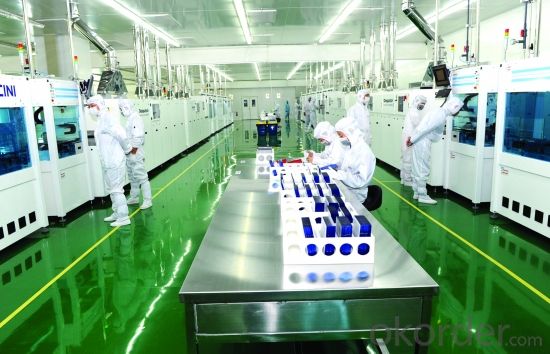
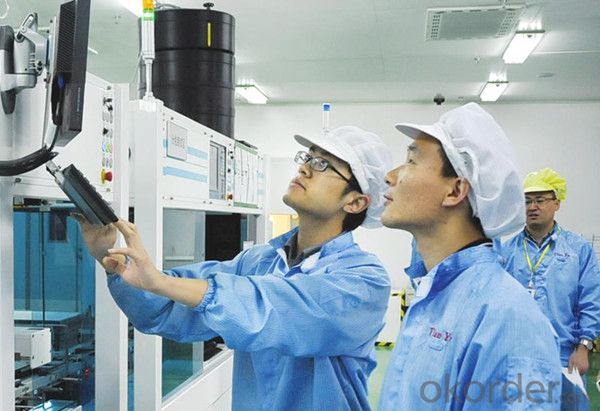
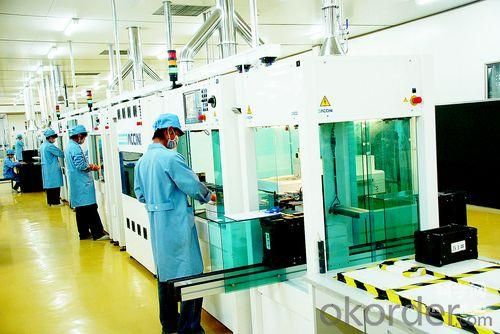
FAQ
We have organized several common questions for our clients,may help you sincerely:
1. What’s price per watt?
A: It’s depends on the quantity, delivery date and payment terms of the order. We can talk further about the detail price issue. Our products is high quality with lower price level.
2. Can you tell me the parameter of your solar cells?
We have different series of cells with different power output, both from c-si to a-si. Please take our specification sheet for your reference.
3. How do you pack your products?
We have rich experience on how to pack the panels to make sure the safety on shipment when it arrives at the destination.
4. Can you do OEM for us?
Yes, we can.
5. How long can we receive the product after purchase?
In the purchase of product within three working days, We will arrange the factory delivery as soon as possible. The perfect time of receiving is related to the state and position of customers. Commonly 7 to 10 working days can be served.
- Q: What is the impact of solar cells on reducing energy waste?
- Solar cells have a significant impact on reducing energy waste as they harness the sun's energy to generate electricity without emitting greenhouse gases or consuming any fossil fuels. By converting sunlight into usable electricity, solar cells enable a greener and more sustainable energy source, ultimately minimizing the need for traditional, non-renewable energy sources and reducing overall energy waste.
- Q: What is the role of trackers in solar cell systems?
- Trackers in solar cell systems are devices that help optimize the performance of solar panels by following the movement of the sun throughout the day. Their role is to ensure that the solar panels are always facing the sun at the optimal angle, maximizing the amount of sunlight they receive. This leads to increased energy production and improved efficiency of the solar cell system.
- Q: How to define the poly solar cells as the A Grade one?
- It is hard to tell if the poly solar cells you bought has no certificate, ganratees.
- Q: How do solar cells perform in areas with frequent tornadoes?
- Solar cells can perform well in areas with frequent tornadoes as long as they are properly designed and installed to withstand extreme weather conditions. While tornadoes can potentially damage or destroy solar panels, advancements in technology have made solar cells more resilient. Additionally, solar panels can be reinforced or mounted securely to minimize the risk of damage. It is important to consider the specific location and design of the solar installation to ensure it can withstand tornadoes and other severe weather events.
- Q: Can solar cells be used in railway applications?
- Yes, solar cells can be used in railway applications. They can be installed on railway tracks, train roofs, or station roofs to generate electricity and power various railway systems, such as signaling, lighting, and communication systems. Additionally, solar cells can also be used to charge batteries in trains or provide power for onboard equipment, reducing reliance on traditional sources of energy and promoting sustainability in the railway industry.
- Q: What is the impact of bird droppings on solar cell performance?
- Bird droppings can significantly impact solar cell performance by reducing the amount of sunlight reaching the surface of the cells. The droppings can act as a physical barrier, blocking sunlight and reducing the efficiency of the solar cells in converting sunlight into electricity. Additionally, the chemical composition of bird droppings can cause corrosion and damage to the surface of the cells, further degrading their performance over time. Regular cleaning and maintenance are essential to ensure optimal solar cell efficiency and prevent any long-term negative impact from bird droppings.
- Q: What is the role of voltage regulators in solar cell systems?
- The role of voltage regulators in solar cell systems is to ensure a stable and regulated output voltage from the solar panels. They act as a control mechanism to prevent overcharging of batteries or damage to electronic devices by regulating the incoming voltage from the solar cells. Voltage regulators also help optimize the efficiency of the solar cell system by matching the voltage levels of the solar panels with the load requirements, thereby maximizing the energy conversion and utilization.
- Q: Can solar cells be used for wireless communication devices?
- Yes, solar cells can be used for wireless communication devices. Solar cells convert sunlight into electrical energy, which can power various devices including wireless communication devices such as smartphones, tablets, or even Wi-Fi routers. This enables the devices to operate without relying on traditional power sources, making them more flexible and sustainable.
- Q: Can solar cells be used in powering irrigation systems?
- Yes, solar cells can be used to power irrigation systems. Solar panels convert sunlight into electricity, which can be used to power pumps or other necessary components of irrigation systems. This offers a sustainable and cost-effective solution for providing power to irrigation systems in areas with limited access to electricity.
- Q: Can solar cells be used in cloudy or rainy conditions?
- Yes, solar cells can still be used in cloudy or rainy conditions, although their efficiency may be reduced compared to sunny conditions.
Send your message to us
Best Solar Cells - Polycrystalline Solar Cells Tire 1 Manufacturer -17.4%
- Loading Port:
- Shanghai
- Payment Terms:
- TT OR LC
- Min Order Qty:
- 10000 pc
- Supply Capability:
- 50000000 pc/month
OKorder Service Pledge
OKorder Financial Service
Similar products
Hot products
Hot Searches
Related keywords
